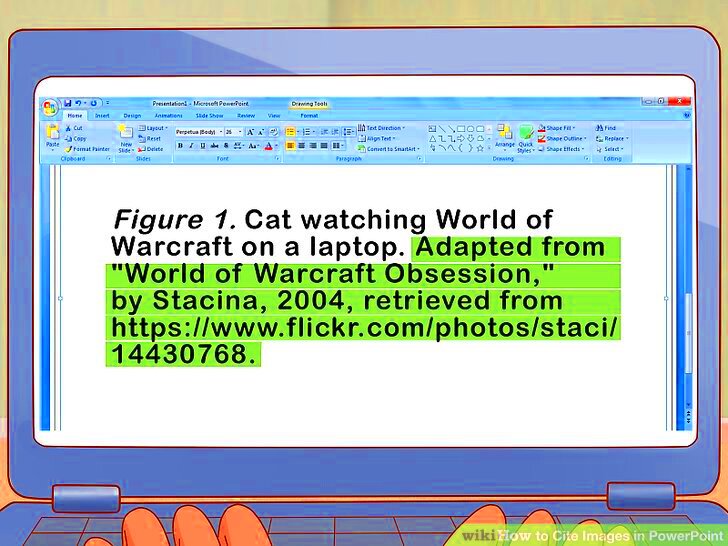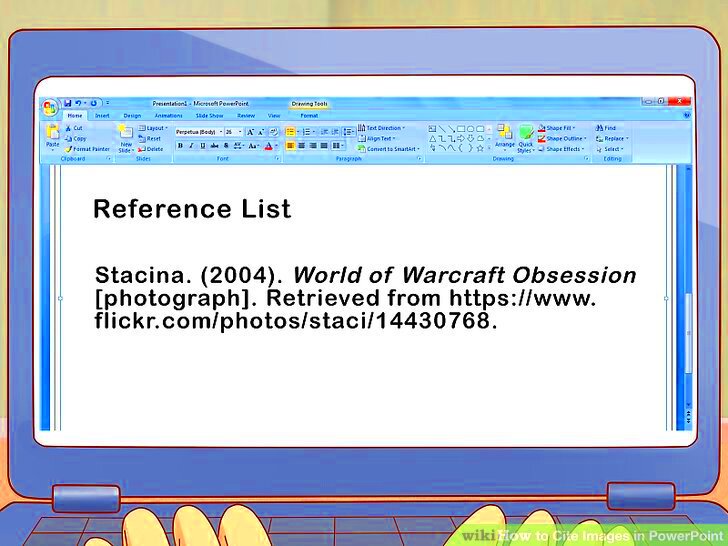How frequently do you use images in your PowerPoint presentations? Is it essential to include citations for those pictures? When it comes to PowerPoint presentations, citing images is not only a best practice but also an important requirement. This demonstrates respect for image creators and circumvents any potential legal issues. However, if you fail to include the necessary references when using
As a part of being trained on data until October 2023, it is important to also note how image citation boosts credibility when presenting. It shows that one has conducted research and there is respect for other people’s work. Giving appropriate credit creates a professional outlook for an individual and the kind of work they do. Clear citations also let audiences retrace the information sources used in their respective minds hence leading to belief lastly depending yourself as a source of information is considered as having low self-esteem especially in this era where it’s being pointed out by experts such as psychologists etc.
Identifying Image Sources in PowerPoint

In case of utilizing visuals within PowerPoint presentations, it is important to be aware of their sources. The article below outlines basic processes needed to recognize image sources:
- Check the Metadata: Right-click on the image in PowerPoint and select "Format Picture." Look for the metadata, which may include the image's origin.
- Search the Internet: If you found the image online, use a reverse image search tool to trace its source.
- Note the Source at the Time of Download: Always save the link or note the website from which you downloaded the image.
- Use Stock Image Websites: Reliable stock image platforms, like HD Stock Images, provide clear information about image usage rights.
The crucial first move to clueless referencing is being careful at establishing image origins.
Using the Reference Slide for Citing Images
In your PowerPoint presentation, an efficient way of acknowledging images would be through a reference slide. All the images utilized can be included in this bibliography. The following are steps for creating it:
- Create a New Slide: Add a new slide at the end of your presentation specifically for references.
- List Your Images: Write down the images used in the presentation, along with their sources.
- Include Relevant Details: For each image, add the title, creator’s name, the website link, and the date accessed if applicable.
Constucting a table is heavy; however, it might be done more easily if one can stick to the format indicated below:
| Image Title | Creator | Source |
|---|---|---|
| Beautiful Sunset | Jane Doe | www.stockimages.com/sunset |
| City Skyline | John Smith | www.stockimages.com/skyline |
For slide reference, it becomes easy for your audience to get more details on the images thus boosting your presentation’s professionalism.
How to Cite Images from Stock Photo Websites
The importance of giving appropriate references to images from stock photo websites cannot be underestimated as it protects their copyright rights and also recognizes the ownership of creators. Most stock photo websites have guidelines on proper usage of their photographs, but you should also learn how to correctly cite them in your PowerPoint presentations. Doing this will not only help in keeping away from having any legal problems but will also portray you as a professional person in whatever you’re doing.It is significant to realize that citing photographs from stock photography sites is imperative for adhering to copyright laws protecting ownership of photographs by those who produced them. Being aware of proper citation methods is important even though many stock image sites provide information about the use of images on them, especially when creating PowerPoint presentations. This contributes towards self-preservation and portrays professionalism.
Here is a basic manual on how to reference photographs from stock photo sites:
- Check the License: Before using any image, always check its licensing terms. Most stock sites, like HD Stock Images, provide information about how the image can be used and any necessary attributions.
- Gather Necessary Information: When you download an image, note down the following details:
- Image title
- Photographer’s name
- Website name
- Direct URL link to the image
- Use Proper Citation Format: Depending on your citation style (APA, MLA, etc.), structure your citation accordingly. For example:
- APA: Photographer's Last Name, First Initial. (Year). Title of image [Format]. Website Name. URL
- MLA: Photographer’s Last Name, First Name. Title of Image. Website Name, Year, URL.
By adhering to these procedures, you can be certain that you acknowledge properly and also safeguard your creation when utilizing image banks.
Adding Image Credits in Speaker Notes
Incorporating image citations in your speaker notes is a great way to maintain clarity and professionalism in your presentation without making your slides look cluttered. With this approach, you refer to your sources without having to mess up with visual things. Below are some of the ways that one can utilize image citations within speech notes:
- Open Speaker Notes: In PowerPoint, navigate to the slide where you’ve used an image. At the bottom of the screen, you’ll see the speaker notes section.
- Type the Image Citation: Write the citation information just like you would on a reference slide. Include:
- Image title
- Photographer’s name
- Source URL
- Keep It Concise: You don’t need to include every detail in your notes. Just enough information to remind you of the image source should suffice.
Not only this will keep your slide look great visually but also it ensures that you have everything you need when talking in front of people.
Formatting Image Citations in Your Slides
Formatting image citations in PowerPoint slides is a key step for clarity and professionalism. A properly structured citation allows your audience to know where you’ve sourced your images from and also respects the copyright laws. This is how you can effectively format your image citations:
- Choose a Consistent Format: Decide on a citation style (APA, MLA, etc.) and use it consistently throughout your presentation.
- Position the Citation: Place the citation directly under the image or at the bottom corner of the slide to keep it unobtrusive. This placement helps in maintaining visual flow.
- Use Legible Fonts: Make sure the text is readable. A font size of at least 10-12 points is generally recommended for citations.
- Example of Citation: Here’s how a citation might look:
Beautiful Sunset. Jane Doe. www.stockimages.com/sunset.
Well-structured citations not only boost your presentation’s professionalism but also serve as a means of allowing your audience to delve deeper into the pictures.
Common Citation Styles for Images
Regarding images of citation, every style has its own specific procedures and rules. It is essential to be aware of what style to employ as this could greatly affect your audience's perception of your work. The common styles are APA, MLA and Chicago among others; they all have their individual regulations on citing images. Below is a summary to help you in proper referencing of pictures based on the popular citation styles.
| Citation Style | Format for Citing Images |
|---|---|
| APA | Last Name, First Initial. (Year). Title of image [Format]. Website Name. URL |
| MLA | Last Name, First Name. Title of Image. Website Name, Year, URL. |
| Chicago | Last Name, First Name. Year. "Title of Image." Website Name. URL. |
For instance, the image named “Awesome Nature” by John Doe, linked from a site with selling images would appear in various forms such as:
- APA: Doe, J. (2023). Stunning Landscape [Photograph]. StockPhotos.com. www.stockphotos.com/stunning-landscape
- MLA: Doe, John. Stunning Landscape. StockPhotos.com, 2023, www.stockphotos.com/stunning-landscape.
- Chicago: Doe, John. 2023. "Stunning Landscape." StockPhotos.com. www.stockphotos.com/stunning-landscape.
Utilizing accurate citation styles serves not only to enhance audience comprehension of the sources but also to legitimize the work being done.
Frequently Asked Questions about Citing Images
Citing pictures, on the other hand, can be tricky, particularly if you don’t know how to go about it. The following are some of the most common inquiries regarding image citations in PowerPoint presentations that we will answer for you.
- Do I need to cite every image? Yes, you should cite every image you use that is not your own. This includes images from the internet, stock photo websites, and even images you’ve altered.
- What if the image doesn’t have an author? If no author is listed, start with the title of the image instead. If the title isn’t available, use a description in brackets.
- Can I use images without permission? It depends on the image’s licensing. Always check the licensing terms to ensure you’re compliant. Images from stock photo sites typically come with clear usage rights.
- How do I handle images from social media? For images from social media, provide the username of the account that posted the image, along with the platform name and URL.
- What if I’m using images for educational purposes? Even for educational use, it's best to cite your sources. This practice shows respect for the creator’s work and helps you avoid any potential copyright issues.
Deciphering these common questions can help make everything clearer and eases the citation of pictures.
Conclusion on Citing Images in PowerPoint
In summary, including images in PowerPoint presentations is not only a matter of formality but also an important practice when it comes to ethics and professionalism. Proper attribution can protect you from copyright infringement while acknowledging the efforts made by creators of those pictures. Using stock photo websites, personal collection of images or the internet are some way in which may be used for making citations on visuals as they will help raise presenter’s trustworthiness by means of them being careful with how they acknowledge these pictures.
Keep in mind that as you prepare your presentations for the audience to see, there are some things you need to pay attention to:
- Choose the right citation style for your audience.
- Use a reference slide or speaker notes for citations.
- Ensure that every image is cited appropriately.
The audience will find you to be more credible and dependable once you adhere to these guidelines thus giving your presentation a professional touch. To start off, tap into your creativity when it comes to visuals; do remember to give credit where it is due!

 admin
admin








